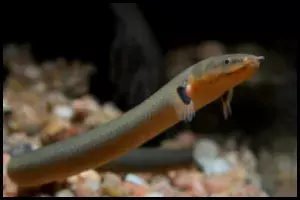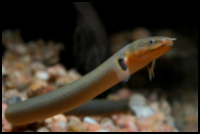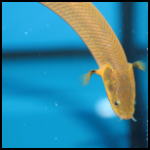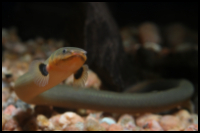




Quick Care Details (Table)
| Livestock Characteristics | Value |
|---|---|
| Care Level | Easy |
| Temperament | Peaceful |
| Diet | Carnivore |
| Maximum Size | 1ft & 3 Inches |
| Minimum Tank Size | 50 Gallons |
| Plant Safe | Yes |
| Temperature Range | 72-82F |
| PH Range | 6.0-7.5 |
| KH Range | 8-22 |
Species Specific Categories
Helpful Video
Care Details
Aquascape: Rope Fish thrive in aquariums with plenty of hiding spots. Use caves, driftwood, and dense plantings to create a secure environment. Floating plants provide cover at the water's surface and mimic their natural habitat.
Substrate: Opt for a fine, sandy substrate, as Rope Fish like to burrow and sift through the substrate. This type of substrate is gentle on their delicate undersides.
Disease Prevention: Maintaining high water quality is essential for preventing diseases. Regular water changes, quarantining new additions, and providing a stress-free environment are key to their health.
Filtration: Efficient filtration is crucial to maintain water quality. Canister filters or sponge filters work well. Ensure the filter intake has a protective cover to prevent Rope Fish from getting caught.
Lighting: Rope Fish do not have specific lighting requirements. Moderate to low lighting is generally suitable, and this can also help reduce algae growth.
Water Flow: They prefer gentle water flow. Avoid strong currents, as they are not strong swimmers and may struggle in rapid flows.
Hardiness: Rope Fish are hardy when kept in appropriate conditions. They can adapt to a range of water parameters but prefer stable, slightly acidic to neutral water.
Acclimation: When introducing Rope Fish to a new tank, acclimate them slowly to avoid stress and temperature shock. Gradually mix tank water with the water in the bag or container they came in.
Expected Lifespan: With proper care, Rope Fish can live for around 7-10 years, making them a long-term commitment in the aquarium hobby.
Special Requirements: Rope Fish require caves and hiding places in their aquascape, as well as a tightly secured lid to prevent escapes. They also appreciate floating plants and a quiet, low-stress environment. Ensure tankmates are non-aggressive and large enough not to be seen as potential prey.
Temperament and Behavior
Behavior: Rope Fish, with their elongated, snake-like bodies, exhibit fascinating and deliberate behavior. They are known for their inquisitiveness, often exploring their surroundings with grace. These fish are peaceful by nature and prefer to be in pairs or small groups. They can also breathe air at the surface, which is a unique and captivating trait.
Breeding: Breeding Rope Fish in home aquariums can be challenging due to their specific requirements. They are egg layers and will lay their eggs on submerged vegetation. Providing a separate breeding tank with dense plant cover is essential for their successful reproduction.
Aggression: Rope Fish are among the least aggressive aquarium species. They are docile and rarely display aggression towards other fish. However, they may eat smaller tankmates that can fit in their mouth.
Tankmates Compatibility: They are generally compatible with other peaceful, non-aggressive fish. Good tankmates include African tetras, larger peaceful cichlids, and catfish. Avoid keeping them with small fish that may be seen as prey.
Activity Level: Rope Fish have a slow, deliberate activity level. They are not active swimmers and spend much of their time resting among plants or caves. Their quiet nature adds a sense of calm to the aquarium.
Schooling or Shoaling Behavior: Rope Fish do not exhibit schooling or shoaling behavior. They are more solitary by nature and prefer their own space.
Plant Compatibility: Rope Fish are generally plant-friendly and won't harm aquatic plants. However, they may occasionally uproot plants when exploring, so ensure that plants are securely anchored in the substrate.
Diet and Nutrition
Dry Foods: Rope Fish can be trained to accept high-quality dry foods like pellets and flakes, which provide a balanced diet. However, these should be offered in moderation as part of their diet.
Frozen Foods: Frozen foods such as bloodworms, brine shrimp, and daphnia are highly appreciated by Rope Fish. These offer essential nutrients and variety to their diet.
Live Foods: Live foods like earthworms, small fish, and insect larvae are a staple in their diet. They prefer live prey due to their carnivorous nature and will readily hunt for them.
Vegetables: While Rope Fish are primarily carnivorous, they may occasionally nibble on blanched vegetables like zucchini or cucumber. However, these should be considered supplementary rather than a primary source of nutrition.
Algae: Rope Fish are not known to consume algae, so they do not contribute significantly to algae control in the tank.
Feeding Schedule: Rope Fish are nocturnal and prefer to feed during the evening or night. Feed them 2-3 times a week, offering a mix of live and frozen foods, supplemented with dry foods for dietary variety.
Supplemental Foods: To enhance their diet and overall health, consider using supplements like vitamins and minerals. These can help ensure they receive all the necessary nutrients.
Tank Parameters
Tank Size: For a single Rope Fish or a small group, a tank of at least 55 gallons (208 liters) is recommended. A larger tank of 75 gallons (284 liters) or more is even better, providing ample swimming space and hiding spots.
Tank Length and Measurements: Opt for a tank that is at least 48 inches (122 cm) in length. The length is more important than height, as it accommodates their elongated bodies and allows them to explore comfortably.
Water Temperature: Maintain the water temperature within the range of 75-82°F (24-28°C). They prefer slightly warmer water, similar to their native African habitats.
pH (Acidity/Alkalinity): Rope Fish thrive in slightly acidic to neutral water conditions with a pH range of 6.0-7.5. Consistency in pH is key to their well-being.
KH (Carbonate Hardness): A KH level of 5-15 degrees is suitable, as it helps buffer pH and prevents fluctuations.
GH (General Hardness): Maintain a GH level of 6-20 degrees. They can adapt to a range of water hardness levels but prefer moderately hard water.
Hardiness: Rope Fish are considered hardy when kept within their preferred water parameters and provided with a suitable environment. They are a great choice for aquarists with some experience.
Nitrate (NO3) Levels: Regularly monitor and keep nitrate levels below 20 ppm (parts per million) through water changes and efficient filtration. Low nitrates contribute to their overall health.
History, Popularity, History and Species Variety Details
The history, popularity, and natural habitat
History: The Rope Fish (Erpetoichthys calabaricus) is a unique and intriguing species that has captured the attention of aquarists for many years. These fish originate from the slow-moving freshwater rivers and streams of West and Central Africa. They belong to the Polypteridae family, which includes ancient fish species. Rope Fish have been cherished in the aquarium hobby for their fascinating appearance and distinctive behavior. They are sometimes referred to as "Reedfish" due to their elongated, rope-like bodies.
Popularity: Rope Fish have gained popularity among aquarium enthusiasts who appreciate their distinctive appearance and peaceful nature. While they are not as common as some other aquarium fish, they have a dedicated following. Their unique behavior, which includes a snake-like undulating motion, is a source of fascination for many hobbyists.
Natural Habitat: In their native habitat, Rope Fish are typically found in slow-moving or stagnant waters, often in swampy regions and densely vegetated areas. They have adapted to life in areas with low oxygen levels, which is why they have the ability to breathe atmospheric air. Rope Fish are skilled at navigating through submerged plants, reeds, and debris, which serve as both camouflage and protection.
Understanding the history, popularity, and natural habitat of the Rope Fish sheds light on why they are such intriguing and sought-after aquarium inhabitants. Their unique features and behavior make them a captivating addition to freshwater tanks.
- Zigzag Eel (Mastacembelus armatus): These eels have a zigzag pattern on their body and a long, slender shape. They are relatively peaceful but can be territorial. They need spacious tanks and hiding spots.
- Peacock Eel (Macrognathus siamensis): Known for their attractive pattern and colors, Peacock Eels are peaceful and prefer hiding spots and soft substrate for burrowing.
- Fire Eel (Mastacembelus erythrotaenia): These eels have a vibrant red coloration and require a large tank with plenty of hiding spots and open swimming space.
- Spiny Eel (Macrognathus spp.): This group includes various species of spiny eels, each with unique appearances and requirements. They are generally peaceful and prefer live or frozen foods.
- Bichir (Polypterus spp.): While not true eels, Bichirs have a similar elongated appearance. They are ancient fish species and come in various species and sizes.
- European Eel (Anguilla anguilla): European eels are occasionally kept in home aquariums, although they have complex life histories and require brackish or saltwater conditions to complete their life cycle.
Frequently Asked Questions
Are Rope Fish suitable for beginners?
Rope Fish are generally best for intermediate to advanced aquarists due to their specific care requirements, but with proper research, beginners can also keep them.
What size tank do Rope Fish need?
A tank of at least 55 gallons is recommended for a single Rope Fish, with larger tanks providing more space and comfort.
Can Rope Fish be kept in a community tank?
Yes, they can coexist with peaceful, non-aggressive tankmates like African tetras and larger, peaceful cichlids.
Do Rope Fish breathe air like Lungfish?
Yes, Rope Fish have a unique adaptation that allows them to breathe air at the water's surface, much like Lungfish.
How often should I feed my Rope Fish?
Offer a varied diet of live and frozen foods 2-3 times a week, and supplement with high-quality dry foods.
Are Rope Fish compatible with plants in the aquarium?
Yes, they are plant-friendly and won't harm aquatic plants. However, they may occasionally uproot plants when exploring.
Do Rope Fish have any specific lighting requirements?
They don't have specific lighting needs; moderate to low lighting is usually suitable.
What's the lifespan of a Rope Fish?
With proper care, Rope Fish can live for about 7-10 years, making them a long-term commitment.
Are Rope Fish aggressive?
Rope Fish are peaceful and not aggressive toward other fish. However, they may eat small tankmates that fit in their mouth.
Can I breed Rope Fish at home?
Breeding Rope Fish can be challenging, but it's possible with a separate breeding tank, dense plant cover, and patience.

